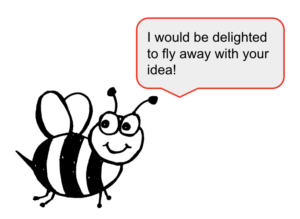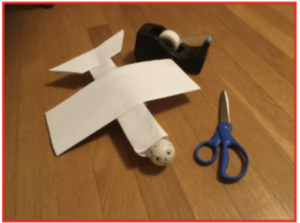INTEGRATING SCIENCE, TECHNOLOGY, ENGINEERING AND MATHEMATICS (STEM) INTO THE HOME ENVIRONMENT
Make Your Idea Fly
ENGINEERING TASK
Inspired by “What Do You Do With an Idea?” by Kobi Yamada

MATERIALS IN KITS
Let’s check the materials in the kit. Will you help me count?
- 1 ping-pong ball
- 10 craft sticks
- 5 rubber bands
- 4 paper plates
- 10 paper clips
- 4 aluminum foil sheets
- 5 pipe cleaners
- 5 straws
- 4 pieces of construction paper
- 1 roll of tape
- 1 pair of scissors
You can also use recyclable materials (e.g., egg cartons, paper towel rolls, food boxes).
READ & TALK
Read the book, What Do You Do with an Idea.
In the story, a child got an idea and did not know what to do with it. Have you ever had an idea? What was it? What did you do with it? Did you share it, hide it, protect it? Did anyone ever tell you that your ideas were silly or weird? The idea in the story taught the child to think outside the box and at the end, the idea changed, spread its wings and took flight.
Additional Consideration: We encourage you to share an idea that you have had and what you did it.
ENGINEERING TASK
 Your engineering task is to build something that will make your idea (a ping pong ball) fly.
Your engineering task is to build something that will make your idea (a ping pong ball) fly.
THINK TIME
Have you ever seen something flying? Tell me about it.
What do you think makes these things fly? Let’s make a list.
Additional Considerations:
You said _____ (e.g., helicopter). How would that work?
Do I have your permission to add to our list? [Other things to consider for making something fly may include a catapult, a bird, a zipline, a frisbee, and a slingshot.]
RESEARCH
 Did you know there are jobs in which people design and build machines that fly. They are called aerospace engineers.
Did you know there are jobs in which people design and build machines that fly. They are called aerospace engineers.
Watch the video to learn more:
What other things do you think aerospace engineers design and build? What about balloons? Or kites? Let’s add to our list.
PLAN
Based on your list, pick 2-3 flying machines to make your idea fly. Design/sketch what each flying machine will look like.
What material will we need to make _______?

CREATE
Pick one of your designs to create something that will make your idea fly.


TEST
 Will your flying machine carry your idea? How high and how far will it go?
Will your flying machine carry your idea? How high and how far will it go?
Place your idea (or ball) inside the flying machine. Make your machine go.
Did your flying machine make your ‘idea’ fly? Did your ‘idea’ stay safe? How far did your ‘idea’ fly? What objects might we use to measure the distance? How might we use our feet or the paper clips?
IMPROVE
Based on the test, what changes should we make to the flying machine? Why? Should we use different material? Tell me more.
Make these changes to your flying machine. Keep testing and redesigning the until you are satisfied. This is what we call iteration.

COMMUNICATE
Engineers have to be able to talk about their process and their prototype to a wider audience.
Here are a few questions to talk through:
- What makes your flying machine unique?
- Explain how well (or not so well) your flying machines carried your idea.
- If you could go back in time, would you use different materials? Why or why not? If yes, what materials would you use?
SHARE THE FUN AND PASS IT ON!
Thank you for participating.
When you are done with this project, gift the book and the directions to your friend to make the idea of engineering fly.

PLAN – OPTIONAL QUESTIONS
- What makes each of your designs unique?
- I think we should name each of the designs. What did you name this one? Why?
- What were you thinking when designing or sketching the different flying machines?
- Is there a way to not use so much tape? How might we use the rubber bands or pipe cleaners?
- What are things in our home that we might use to create ____?
TEST – OPTIONAL QUESTIONS
Normalize failure and encourage a growth mindset. Use the power of “not yet.” Optional questions to ask:
- Would you consider this test a success or failure? Tell me why.
- What change(s) should we make in the next step (i.e., redesign)? What happened in the test that makes you think this?
- Let’s try the test from different sitting and standing positions to see how it works. What do you notice?

